Servicios Personalizados
Articulo
Indicadores
Links relacionados
-
 Citado por Google
Citado por Google -
 Similares en Google
Similares en Google
Compartir
Water SA
versión On-line ISSN 1816-7950
versión impresa ISSN 0378-4738
Water SA vol.45 no.2 Pretoria abr. 2019
http://dx.doi.org/10.4314/wsa.v45i2.16
Requirements for sustainable operation and maintenance of rural small-scale water infrastructure in Limpopo Province, South Africa
MS SelalaI; A SenzanjeI; K DhavuII, *
ISchool of Engineering, University of KwaZulu-Natal, Pietermaritzburg, South Africa
IIInstitute of Agricultural Engineering, Agricultural Research Council, Private Bag X519, Silverton, Pretoria, South Africa
ABSTRACT
This study assessed the presence of key requirements for sustainable O&M and rehabilitation of rural small-scale water infrastructure in Makhudutamaga Municipality in South Africa. The study found a significant correlation between the requirements for sustainable O&M and rehabilitation of rural small-scale water infrastructure and continuity of service provision (p < 0.001) by the small-scale water infrastructure as well as functionality (p < 0.001) of the small-scale water infrastructure hardware. The study concludes that the presence of the key requirements varies as a function of social dynamics of communities and the presence of these requirements has an impact on the functionality and continuity of the small-scale water infrastructure hardware.
Keywords: continuity of service, functionality, household survey, robustness of hardware
INTRODUCTION
South Africa has adopted various practices and technologies in order to improve the reliability of rural water supply, including rainwater harvesting (Kahinda et al., 2007), handpump-equipped boreholes and engine pump-equipped boreholes (standpipes) (Hazelton, 1994; Senzanje et al., 2013). These were collectively defined by Senzanje et al. (2012) as rural small-scale water infrastructure (SWI). Rainwater harvesting has recently gained popularity, with most government projects focusing on development of such systems (Kahinda et al., 2007). However, over the past 2 decades handpumps and standpipes were common rural SWI, developed either through government- or donor-funded projects, and were and still are the main sources of water supply for most rural areas of South Africa (Hazelton, 1994).
Sustainability of small-scale water infrastructure is defined by continuity of water supply, functionality of equipment and reliability of the infrastructure. Condition of small-scale infrastructure is the status of the infrastructure as related to its ability to maintain its functionality, continuity and reliability. For example, if an infrastructure is in excellent condition it is capable of being used to its full designed purpose without being modified and not requiring any repairs or maintenance at the time of condition assessment or in the near future.
Adoption of SWI for improvement of rural water supply is a global phenomenon, but studies have shown that handpumps and standpipes are largely adopted in Africa and Asia (Harvey and Reed, 2004; Prokopy, 2005). From the available literature, there appear to be high levels of unsustainability (poor performance, non-operational) of existing SWI (Parcey, 1976; Hazelton, 1994; Harvey and Reed, 2004; Sutton, 2004; Hoko and Hertle, 2006; Gbadegesin and Olorunfemi, 2007, Senzanje et al., 2013) particularly in Sub-Saharan Africa (SSA). As an example, studies recorded the following proportions of SWI to be out of operation: 25% - Mangwe, Zimbabwe; 50% - Vhembe District, Limpopo, South Africa (SA); 60% - Swaziland. Another study, by Sambo (2015), reported poor performance in 72% of the SWI in Sekhukhune District, Limpopo, SA.
The unsustainability of SWI is a common phenomenon that requires appropriate management strategies - sustainability SWI is complex and is affected by various factors reported in the literature. Various studies have categorized these as: socio-institutional (Harvey and Reed, 2004; Peter and Nkambule, 2012; Senzanje et al., 2013), technical (Rietveld et al., 2009; Senzanje et al., 2013; Sorlini et al., 2013), economic or financial (Botha et al., 2001; Sutton, 2004; Harvey, 2007; Senzanje et al., 2013) and environmental (Peter and Nkambule, 2012; Sorlini et al., 2013). Lack of maintenance and rehabilitation appeared to be major contributing factors towards low levels of SWI sustainability (Waughray et al., 1997; Sutton, 2004; Senzanje et al., 2013).
There also appear to have been loopholes in SWI development pathways that have led to maintenance and rehabilitation being neglected (Senzanje et al., 2013). In a recent study (Selala, 2016), key factors have been gathered to develop requirements for sustainable O&M and rehabilitation of SWI under the themes of socio-institutional, financial and technical. These include:
•Socio-institutional: SWI users' sense of ownership towards SWI, SWI users' willingness to participate in the management of SWI, the existence of SWI management structures.
•Financial: the availability of financing mechanisms, SWI users' willingness to pay.
•Technical: robustness of the SWI hardware, the availability of maintenance personnel, and the availability of spare parts at local markets.
Various studies have reported that the existence of such requirements tends to improve the sustainability of SWI, which in turn improves water supply service provision (Sutton, 2004; Peter and Nkambule, 2012).
While assessing the notion of sustainability of SWI, studies have addressed various issues, including evaluation of development projects (Jones and Silva, 2009; Peter and Nkambule, 2012), technical assessment of rural water supply systems (Rietveld et al., 2009) and exploring reasons (Sambo, 2015) for SWI failure. The limitation in these studies is that they neglected the sustainability of O&M and rehabilitation, which is a major concern in rural water supply. Therefore, the central research question addressed in this study is, 'what are the requirements for sustainable O&M and rehabilitation of SWI that are present in rural communities of Makhudutamaga Local Municipality?'. Furthermore, the research sought to ascertain if there was any association between the requirements for sustainable O&M and rehabilitation of SWI and the technical performance of SWI.
Technical performance of SWI is one of the key indicators of their sustainability and has been assessed in various research studies (Sahely et al., 2005; Hoko and Hertle, 2006; Rietveld et al., 2009; Makungo et al., 2011; Majuru et al., 2012). Indicators for evaluating the performance of SWI have been developed from these studies and cover aspects of reliability and condition assessment (Majuru et al., 2012; Sambo, 2015). For the purposes of this study, some components of reliability and condition of SWI as performance indicators were considered and are further elaborated below.
Reliability of SWI hardware
SWI hardware reliability is a good measure of the success or failure of a SWI hardware (Makungo et al., 2011; Majuru et al., 2012; Sambo, 2015). Reliability of small-scale water infrastructure is a measure of the ability and quality of the infrastructure to perform consistently well. In the context of SWI, Hoko and Hertle (2006) and Rietveld et al. (2009) measured reliability in terms of availability and continuity of service provision. Rietveld et al. (2009) also considered functionality or condition of hardware. Availability is a measure of the infrastructure's ability to provide the required amount of water per capita per day (at least 25 L/capita per day in South Africa) and that water must be of good quality. According to the National Water Act (NWA) Act No. 36 of 1998 (RSA, 1998), water users' requirements are said to have been met if both water quantity and quality are satisfied. With regards to maintenance and rehabilitation, of concern is the time it takes from when the SWI breaks down to when it becomes operational again. For the purpose of this study, the ability of the SWI to supply adequate water to water users (availability) was taken to be constant as it is not necessarily affected by maintenance or rehabilitation but by yield. The assumption made was that users would obtain adequate water of good quality for as long as the SWI is functional. The key technical performance indicators considered were continuity and functionality.
Continuity of water supply
Continuity is described, with reference to standpipes, as the consistency of water supply from the main source to the point of water collection (from the pump house to the standpipes). In the context of handpumps, it can be described as consistency of water supply from the aquifer to the water collection facility (Rietveld et al., 2009). Broadly, continuity measures the unbroken and consistent existence or operation of small-scale infrastructure over time. SWI failure directly affects the continuity of water supply, as it might result in unplanned interruption of water supply, which leaves users with limited or no water. Operation, maintenance (O&M) and rehabilitation have been identified as ways to minimize or avoid lack of continuity of water supply.
Rietveld et al. (2009) used the following variables to assess continuity: (i) number of days in a month with unplanned interruption of water supply and (ii) number of hours in a day with unplanned interruption of water supply. From these variables a Continuity Index (Icont) was developed as illustrated by the following equation.

where, Icont is the continuity index, Iday,month is the number of days in a month with unplanned water supply, γi are weighting factors such that ∑γ = 1.
The continuity index is directly linked to the frequency of maintenance and rehabilitation of the SWI hardware. Therefore, continuity is a key variable for measuring reliability of SWI. The threshold or benchmark for continuity in South Africa is set at 7 days in a year, meaning that water supply is considered continuous if the number of days with unplanned interruption of water supply is ≤ 7 days a year (Rietveld et al., 2009; Majuru et al., 2012).
Durability or condition of SWI hardware
The current status of the SWI hardware tells a story about its maintenance and rehabilitation requirements. Rietveld et al. (2009) warned that it is difficult to assess the lifespan of each component of the system. Therefore, the condition of a system can be assessed by simply assessing if it was poorly maintained or not. To assess the functionality or condition of hand pumps, stroke test and leakage test (Hoko and Hertle, 2006) are usually used. In the case of standpipes, the number of standpipes functioning and if adequate water from the main source reaches standpipes are used.
MATERIALS AND METHODS
Study site
The choice of the study site was influenced by the grant project, Challenge Program on Water and Food funded by Consultative Group on International Agricultural Research (CGIAR), which aimed at improving resilience of rural livelihoods within the Limpopo River Basin. The Limpopo River Basin covers four countries (Botswana, Mozambique, South Africa and Zimbabwe). The Limpopo River Basin is a relatively dry basin and most water in the more productive areas is already allocated. Rainfall is highly variable and in many parts of the basin there is little run-off with which to produce crops and livestock. The basin is a water-scarce environment in which recurring drought and floods cause devastating impacts on the livelihoods of small-scale, subsistence farmers. The study sites selected for the assessment were rural communities of Makhudutamaga Local Municipality, which is located in the south of Sekhukhune District Municipality in Limpopo Province, South Africa, as shown in Fig. 1. This study site falls within the Limpopo River Basin, which suffers recurrent water shortages annually. The district has previously had a concerted effort by government and other stakeholders to install SWI to improve water supply.
There were 1 493 operational and non-operational SWI distributed over 137 communities in the study area (sourced from the then Department of Water Affairs (DWA, now Department of Water and Sanitation) SWI database). The types of SWI were predominantly handpumps (60%), standpipes (20%) and windmill-driven pumps and 'other' (20%). Most of these SWI were old systems that had been transferred from the DWA to the Makhudutamaga Local Municipality (Mahlo, 2014) and are maintained by either the local municipality or the community members.
The GPS coordinates obtained from the DWA SWI-database were used to locate SWI on the ground and a GARMIN Etrex 20 GPS was used to mark or confirm the location. The GPS points were captured at each location and the communities where the SWI were found were mapped (Fig. 1). Figure 1 presents the communities sampled in this study as well as their location and type of small-scale water infrastructure found in each of them.
Sampling strategy and data collection
Two sampling strategies were used; sampling of the rural communities and sampling of the households or respondents within identified communities. SWI sampling was based on several factors which included: (i) SWI which were tested to be successful, after installation (as per the DWA SWI database), (ii) SWI which were 60% hand pumps and 40% standpipes, and (iii) functional status of the SWI (both functional and non-functional SWI were considered). With regard to household sampling, the distance from the household to the SWI (near: ≤ 100 m, moderate: 100-500 m, far: 500 m-1 km) was used as the main determining factor and target respondents were heads of households who were using SWI during the survey period or have used it at some point.
The survey questionnaire was developed through an interactive process. Pre-testing or piloting was carried out in 13 communities of which only two became part of the study after the questionnaire was revised. Pre-testing was an exercise of piloting/testing our draft questionnaire before going out to the larger stakeholders. A revised questionnaire was employed to collect data during April 2014, 4 months after pre-testing. Surveys were carried out in the local language (Sepedi), with assistance from 3 enumerators. A questionnaire was administered to 299 respondents for the communities; one key respondent from the Water Services Authority (WSA) and one key respondent from the DWAin the area were also interviewed as key informants. The 299 respondents were drawn from 15 different communities of Makhudutamaga Local Municipality. Respondents were asked about socio-institutional, technical and financial issues related to the SWI. Additionally, respondents were asked about household water supply and some household demographic characteristics.
Stroke and leakage tests were performed on 6 hand pumps which were operational during the survey. A stroke test was performed by pumping water into an 18 L container and counting the number of strokes required to fill the container. A stroke test was considered successful if the maximum number of strokes required to fill an 18 L container within a minute was 40 strokes for Afridev and India Mark II pumps, and 30 strokes for Nira AF-85 hand pumps (Hazelton, 1994).
A leakage test was performed by breaking off pumping for 5 min and recording the number of strokes required for the hand pump to start discharging water. The leakage test was considered successful if water flowed out of the pump outlet within 5 strokes when resuming pumping after 5 min rest following the stroke test (hand pumps) (Hazelton, 1994).
Physical inspection of standpipes to assess their functionality or operational status was performed at 4 sampled communities. The functionality of standpipes was considered satisfactory if 80% were functioning or operational.
Data analysis
Descriptive statistical analyses were used to evaluate if the requirements for sustainable O&M and rehabilitation were present in the study communities. The association between the requirements and the technical performance indicators (functionality and continuity) were determined using Spearman's rho correlation. Data collected for this study was ordinal and, nonparametric, hence the suitability of Spearman's rho correlation (Prion and Haerling, 2014) in determining the correlations.
A 2-tailed test of significance was performed in order to determine the direction and correlation between variables of interest (p < 0.01). Table 1 provides a guide for interpretation of Spearman's rho ranked correlation.

A binary logistic regression model was performed to determine parameters which influenced each of the requirements for the sustainable O&M and rehabilitation in the study area. These analyses were performed using Statistical Package for Social Sciences (IBM-SPSS Statistics Version 22.0).
RESULTS AND DISCUSSION
Assessment of the presence or existence of the requirements for sustainable O&M and rehabilitation in the study area
The results presented in this section are based on the descriptive statistical analysis from questionnaires administered to SWI users in rural communities of Makhudutamaga Local Municipality (Fig. 2). Eight requirements (grouped under socio-institutional, financial and technical factors) for sustainable O&M and rehabilitation were assessed in this study. Figure 2 represents the proportion (as a percentage) of respondents who indicated the presence of different requirements for sustainable O&M and rehabilitation.

From the results in Fig. 2, 7 of the requirements assessed in this study were said to be present by less than 40% of the respondents in all surveyed communities, with the exception of one of the financial factors (willingness to pay for O&M and rehabilitation of SWI) which was demonstrated to be present by 55% of the respondents. A moderately high willingness to pay for O&M and rehabilitation of SWI observed in communities of the study area agrees with the results reported by various researchers (Hoko and Hertle, 2006; Harvey, 2007; Wright et al., 2014). A detailed discussion of each of the requirements based on individual communities is given in the following subsections.
Socio-institutional factors
Users' sense of ownership for SWI
A sense of ownership towards SWI was expressed by less than 33% of the respondents in 73% of the surveyed communities (Fig. 3), indicating a high sense of ownership for SWI by respondents at only 3 of the 15 (20%) surveyed communities, namely Tsatane (96%), Sehuswane (50%) and Maserumule Park (55%).

On average, a sense of ownership towards SWI was expressed by 24.9% of the SWI users in all 15 communities surveyed in this study, indicating a low sense of ownership towards SWI. At Tsatane community, where sense of ownership was highest (96%), the SWI was developed through beneficiaries' contributions and users participated in its construction. In contrast, at Ga-Makgeru where sense of ownership was lowest (3%), the SWI was developed though government-funded projects and had been abandoned during the study. Thus, sense of ownership appeared to be linked to users' contribution towards installation of the SWI. For example, at Maserumule Park users mentioned that they had contributed 50% of the initial investment made towards SWI development and were actively involved in the actual installation process.
A previous study by Marks and Davis (2012) in Kenya concluded that participation in rural water projects improves the users' sense of ownership towards the SWI. Hence, in order to improve the sense of ownership among beneficiaries, some governments only install the SWI after the beneficiaries have made an initial contribution (Hazelton, 1994). For the SWI that are developed through government-funded projects, it is often believed that true sense of ownership could be transferred during handover (Hazelton 1994; Colin, 1999; Harvey and Reed, 2004; Senzanje et al., 2013) of the infrastructure to the rural communities. The SWI remain the legal assets of the implementing agency, so if not formally handed over, community members might be cautious or reluctant to operate and maintain the SWI as they would be perceived not to belong to them (Harvey and Reed, 2004). Handing over the SWI to communities often translates into users assuming ownership (Hazelton 1994).
In the study area, formal handover of SWI to communities had not been implemented. This could explain the low sense of ownership. However, according to Morgan (1993), realistically, community members rarely accept ownership of communal facilities. It can be concluded that there was a low sense of ownership towards the SWI in rural communities of Makhudutamaga which could be associated with: users not having made any meaningful contribution toward SWI development, their lack of participation during construction, and failure of the development agency to hand over the SWI to communities.
Willingness of users to participate in the management of SWI
Willingness to participate in the management of SWI by users was demonstrated by less than 43% of the respondents in 60% of the surveyed communities, with the remaining 40% of the communities' respondents' willingness to participate ranging between 67% and 90% (Fig. 4). On average, 44% of the respondents from all surveyed communities demonstrated willingness to participate in SWI management, indicating a willingness to participate of below 50% which can be considered relatively low.
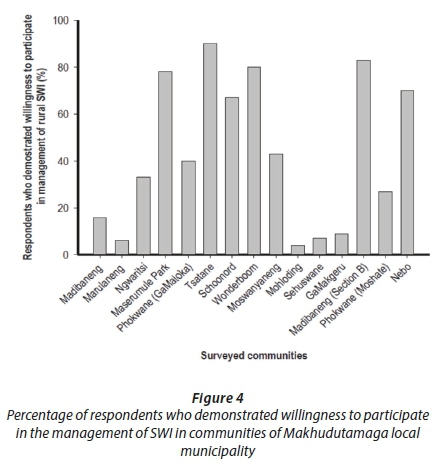
In communities where willingness to participate in SWI management was higher (for example, Maserumule Park, Tsatane, Wonderboom, Madibaneng (Section B) and Nebo), the SWI were the main source of water supply, with an exception of Schoonoord. In contrast, in the remaining communities where willingness to participate in management was lower, 55% of the SWI were used as a supplementary source of water supply. Thus, willingness to participate in SWI management could be linked to whether or not the SWI are a main source of water supply. These results agree with the findings of the study by Waughray et al. (1997) in Zimbabwe, where full-time SWI users have demonstrated high willingness to participate in the management of the SWI.
There are various other factors which are associated with beneficiaries' willingness to participate in the management of SWI which are documented in the literature. Such factors include: gender and the level of education of the respondents (Nisha, 2014). In this study, there was no link between SWI users' willingness to participate in SWI management and the abovementioned factors. The gender aspects could be biased in this study as most of the respondents were female.
Additionally, in the same communities where a high sense of ownership towards SWI was observed, a high user willingness to participate in the management of SWI was also observed. This confirms what the study by Marks and Davis (2012) established - that there is a strong significant correlation between sense of ownership towards SWI and willingness of SWI users to participate in SWI management.
An uncommon factor emerged where users saw no need to participate in SWI management as the municipality is responsible for O&M and rehabilitation of SWI. This was reported in about 70% of the surveyed communities where the users' willingness to participate in SWI management was low, where community members mentioned that their responsibility was only to report broken SWI to the Water Services Authority (WSA) contracted by the local municipality to fix the SWI hardware in the area. This was in line with the response of the WSA and DWA personnel during interviews.
In summary, the willingness to participate in SWI management was found to be relatively low in rural communities of the study area, and appeared to be associated with whether SWI were the main source of water supply, and sense of ownership towards SWI, and the fact that the municipality had promised SWI users free O&M and rehabilitation of SWI.
Availability or the existence of small-scale water infrastructure management structures
Management structures (such as WPCs) were said to be available by less than 16% of the respondents in 93% of the surveyed communities and by 33% of the respondents at Tsatane (Fig. 5), suggesting the lack of formal management structures in all the communities sampled in this study.
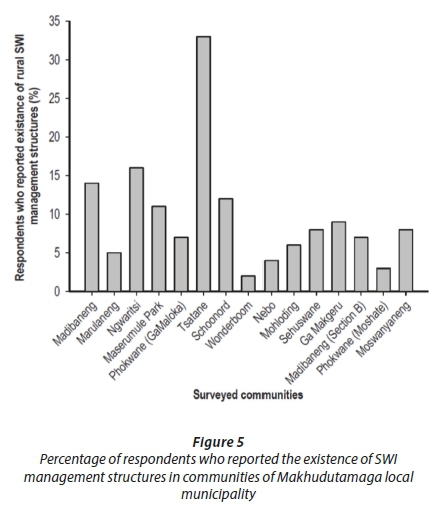
Technically speaking, one could say that what exists can be described as informal management structures, but from a SWI users' point of view, there were no formal management structures. Existence or nonexistence of management structures was found to be significantly associated with users' perception that 'managing SWI at the community level might improve its sustainability' at (p < 0.05) (see Table 2). On the other hand, existence of management structures was found not to be significantly associated with users' perceptions that they should contribute to management of SWI and that establishment of Water Point Committee (WPCs) was necessary for enhancing sustainability (Table 2).
In most cases, WPCs were established during the SWI development stage (Waughray et al., 1997; Harvey and Reed, 2004; Peter and Nkambule, 2012), but most were later discontinued (Hazelton, 1994), which was the case in Ngwaritsi and Phokwane (Ga-Maloka). Surprisingly, at Tsatane where the total capital cost of SWI development was collected through beneficiary contributions, there was no formal management structure. At Tatsane, an informal management setup was in place where anyone could call a meeting when the water infrastructure had broken down, to discuss what needed to be done. Such structures were also reported to be in place in Zimbabwe (Hoko and Hertle, 2006; Lovell, 2000). Generally, WPCs were unavailable in the study area and even those which had existed were reported to have been discontinued. This correlates with Harvey and Reed (2004)'s argument that willingness to manage the SWI does not always translate into establishment of management structures.
In summary, SWI management structures were found to be absent in rural communities of the study area. This could have been influenced by the perception of SWI users that SWI should be managed through the local municipality.
Financial factors
Willingness to pay (WTP) for O&M and rehabilitation of SWI
Willingness to pay (WTP) for O&M and rehabilitation of SWI was demonstrated by more than 43% of the respondents in 73% of the surveyed communities and by less than 3% of the respondents in the remaining 27% of the surveyed communities (Fig. 6), suggesting relatively high willingness to pay for O&M and rehabilitation of SWI at Madibaneng, Ngwaritsi, Maserumule Park, Phokwane (Ga-Maloka), Tsatane, Schoonord, Wonderboom and Moswanyaneng communities and low willingness to pay for O&M and rehabilitation of SWI at Mohloding, Sehuswane, Ga-Makgeru and Madibaneng (B-section) communities.
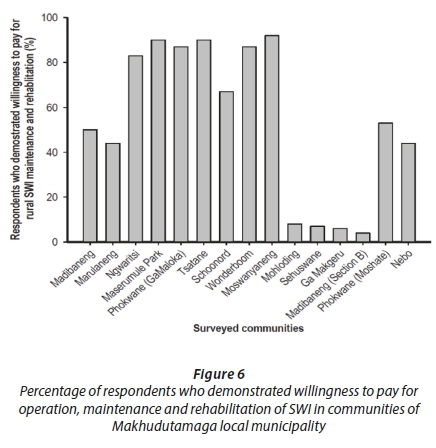
Willingness to pay for O&M and rehabilitation of SWI is often associated with the socio-economic status of the users or the household (Hoko and Hertle, 2006; Harvey, 2007; Wright et al., 2014). WTP for O&M and rehabilitation of SWI was found to be significantly associated with the type of SWI user (at p < 0.001), age of the respondent at (p < 0.05) and the number of people in the household (at p < 0.01) (see Table 3) in surveyed communities.
These results complement the findings of the studies in Uganda and Zimbabwe by Wright et al. (2014) and Waughray et al. (1997), respectively, with regard to WTP being significantly associated with age of the respondent and type of the small-scale water infrastructure user (fulltime and part time). In contrast with some of the findings by Wright et al. (2014) that WTP is associated with level of education of the respondent, distance to the SWI, income and gender of the respondent were found not to be significant at p < 0.001, p < 0.05 and p < 0.1, respectively, as shown in Table 3.
In summary, fulltime SWI users tend to have high WTP for O&M and rehabilitation of SWI. In addition, older users are more willing to pay than younger users and users from households with more members tend to have a high WTP than those with few members. Respondents in the rural communities of Makhudutamaga demonstrated moderately high willingness to pay for O&M and rehabilitation of the SWI in their communities.
Availability of financing mechanisms
Financing mechanisms were said to be available by less than 30% of the respondents in 67% of the surveyed communities and by more than 70% of the respondents in the remaining 33% of the surveyed communities, suggesting that some form of financing mechanism was available in communities such as Ngwaritsi, Maserumule Park, Phokwane (Ga-Maloka), Schoonord, Wonderboom and Moswanyaneng, with a high likelihood of unavailability of financing mechanisms in the remaining communities as shown in Fig. 7.
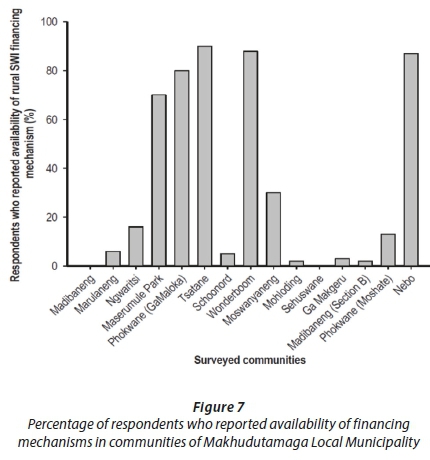
In this context, financing mechanism refers mainly to beneficiary contribution towards O&M and rehabilitation of SWI (Harvey, 2007; Senzanje et al., 2013). At Maserumule Park and Tsatane SWI users reported that there was a beneficiary contribution system where funds are collected when the SWI had broken down. While in other communities where SWI users have reported unavailability of financing mechanism, O&M and rehabilitation are undertaken using government funds.
Availability of financing mechanism was found to be significantly associated with users' willingness to pay for O&M and rehabilitation of SWI (p = 0.008), users' sense of ownership towards small-scale water infrastructure (p = 0.005) and users' willingness to participate in SWI management (p = 0.004), as shown in Table 4. These results indicated that financing mechanisms are often established in communities where users' sense of ownership towards SWI, willingness to pay for O&M and rehabilitation of SWI and willingness to take responsibility for managing the SWI are high or present. Similar findings were reported in Zimbabwe by Hoko and Hertle (2006), in Bangladesh by Prokopy (2005) and various regions of Sub-Saharan Africa by Harvey (2007).
Technical factors
Robustness of the SWI hardware
SWI hardware were said to be robust by less than 50% of the respondents in 33% of surveyed communities and by more than 51% of the respondents in 77% of surveyed communities (See Fig. 8), indicating that 77% of the SWI in the study area were perceived to be robust by their users.
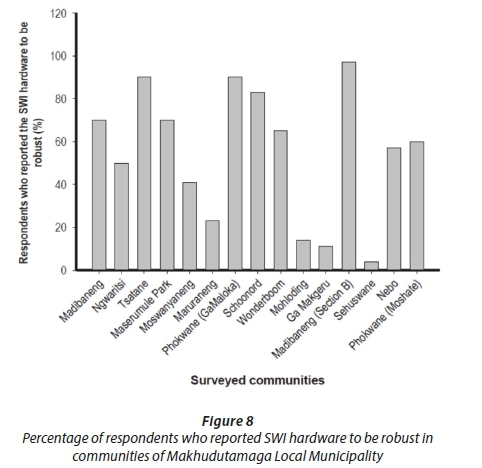
About 70% of the SWI which were said to be robust were operational during the survey period. At Tsatane, Madibaneng and Phokwane (Ga-Maloka), the small-scale water infrastructure were situated within close proximity of the households. This could mean that SWI operation was monitored and chances of the SWI being vandalised, as highlighted by Sambo (2015), were low. Even some of the SWI that were out of operation at the time of the survey were said to be robust. Standpipes were said to be most robust; what seemed less robust was the pump which supplied them with water. It appeared that SWI hardware robustness was significantly associated (p < 0.01) with availability of a set of operational rules (Table 5). This finding agrees with results presented for municipalities of Zimbabwe by Hoko and Hertle (2006), that where SWI users have established a set of operational rules for the SWI, the SWI tended to be robust.
Surprisingly, there was no association between the type of SWI hardware and robustness of SWI hardware. Senzanje et al. (2013) and Sambo (2015) reported vandalism of SWI to be a major issue in the area. These results resonate with most studies which concluded that SWI O&M and rehabilitation problems are linked more to their management than the sustainability of the technical hardware itself (Pacey, 1976; Harvey and Reed, 2004). However, recent studies established that sustainability of SWI in some cases is solely dependent on the SWI structure being poorly constructed or installed (Sambo, 2015).
In summary, SWI users in the study area perceive their SWI to be robust. It appeared that introducing a set of operational rules minimizes the frequency of SWI failure. This confirmed the conclusion by Pacey (1976) that even the best technology will fail if users do not learn its basic operational rules.
Availability of maintenance personnel
Maintenance personnel were said to be available by less than 16% of the respondents in 60% of the surveyed communities, and by more than 44% of respondents in 40% of the surveyed communities (Fig. 9), indicating a low availability of maintenance personnel. It was observed that maintenance personnel were said to be available in communities were standpipes were used. This was mainly because most, if not all, standpipes in the study area were operated by the Water Services Authority, which is a subdivision of the local municipality and has qualified maintenance personnel.
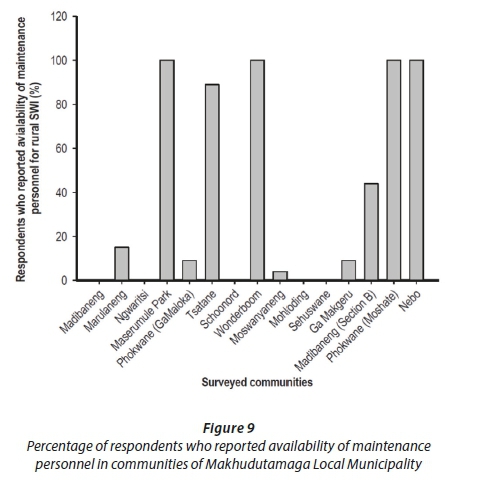
Moreover, the result of 100% of respondents at Wonderboom, Maserumule Park and Phokwane (Moshate) reporting that maintenance personnel were available could be explained by the fact that the local municipality had hired a pump operator for the standpipes who resides within the communities. In the remaining communities, there were no maintenance personnel at the community level. This situation differs from cases where maintenance training was given to the people in the communities when SWI were developed. The situation in the study area differs from most areas where maintenance personnel are either trained among users or alternatively hired from a private company (Harvey and Reed, 2004; Hoko and Hertle, 2006; Peter and Nkambule, 2012).
Availability of spare parts
Spare parts were said to be available locally by more than 50% of respondents in surveyed communities for standpipes and by less than 45% of the respondents in surveyed communities for hand pumps (Fig. 10), indicating that spare parts for standpipes are found locally while spare parts for hand pumps are rare locally.
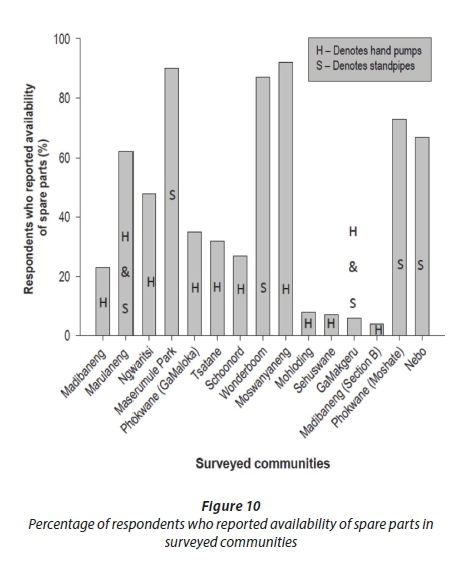
Unavailability of spare parts for hand pumps could be attributed to the fact that most hand pumps were developed 2 to 3 decades ago; thus technology has advanced since then. A study by Hazelton (1994) in the Vhembe district of Limpopo Province revealed that hand pumps found in the area were inherited, thus their spare parts are difficult to find in local markets. However, in this study, it was found that there was no association between the availability of spare parts and the age of the infrastructure. Baraki and Brent (2013) recommended that governments should standardize the type of hand pump hardware to promote healthy market competition and allow for spare parts to be found locally.
Unavailability of spare parts is one of the contributing factors for SWI to remain in a state of disrepair for a long time. In some communities, SWI users opted for locally available material to fix the hand pumps as original spare parts could not be found. Colin (1999) justified unavailability of spare parts in the African region as being related to the fact that their manufacturing is not standardized.
Association between the requirements for sustainable rehabilitation and technical performance indicators
Sustainability of SWI or any water infrastructure is often evaluated based on the sustainability of its service provision in terms of water supply (Rietveld et al., 2009; Peter and Nkambule, 2012). The service provision from SWI is largely dependent on the condition of the SWI (Senzanje et al., 2013). When the SWI hardware has a technical problem, the service provision can be halted or interrupted. Some of the technical problems and impacts associated with them are shown in Fig. 11. The results of the continuity and functionality of the SWI in the study area are as displayed in Table 6.
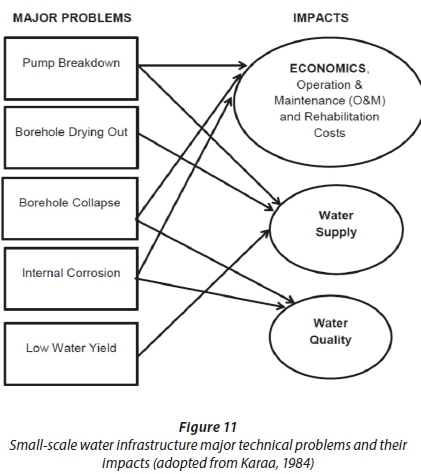
From the results, it shows that 44%, 17% and 39% of the SWI were found to be in good, fair and poor condition, respectively. With regard to small-scale water infrastructure type, 45%, 9% and 44% of the handpumps were in good, fair and poor condition, respectively, while 50%, 17% and 33% of the standpipes were found to be in good, fair and poor condition, respectively (Table 6).
These results correlate with previous studies in the same region and other areas in Limpopo, as reported by Hazelton (1994) and Sambo (2015). Similar studies reported over 35% of the SWI being in a state of disrepair at any given time in Sub-Saharan Africa (Harvey, 2007).
Socio-institutional factors
A series of Spearman rank-ordered correlations were conducted in order to determine if there were any relationships between socio-institutional factors (a sense of ownership towards SWI, the willingness to participation of SWI management and the existence of management structures) and the small-scale water infrastructure technical performance indicators (continuity and condition or functionality).
Users' sense of ownership towards SWI and its continuity and functionality
The results of a two-tailed test of significance (see Fig. 12) indicated that there was a significant positive relationship between users' sense of ownership towards SWI and continuity of the service provided by the small-scale water infrastructure (rs (1) = 0.19, p < 0.01). In communities where users expressed high sense of ownership towards SWI the number of days with interruption of water supply was found to be low (e.g. Tasatane and Maserumule Park). With regard to standpipes, the number of days with interruption of water supply was associated with unavailability of fuel to run the pump. A similar situation was reported by Hazelton (1994) in communities of the Vhembe District, Limpopo Province.
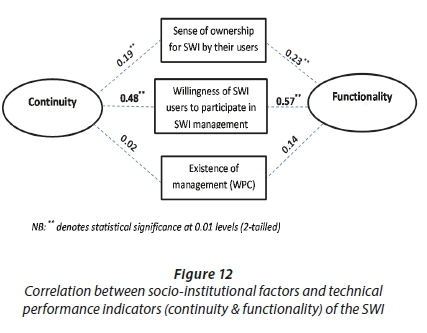
A two-tailed test of significance indicated that there was a significant positive relationship between a sense of ownership towards SWI and functionality of the small-scale water infrastructure (rs (1) = 0.23, p < 0.01). A higher sense of ownership towards SWI was expressed in communities where small-scale water infrastructure were functional during the survey period. This indicated that the higher the users' sense of ownership towards SWI by the better the status of the SWI. These findings agree with those of Marks et al. (2013) in Kenyan SWI. This is a clear indication that sense of ownership towards SWI has an influence on the sustainability of maintenance and rehabilitation of SWI (Marks et al., 2013; Senzanje et al., 2013).
Users' willingness to participate in SWI management and small-scale water infrastructure continuity and functionality
A two-tailed test of significance indicated that there was a significant positive relationship between users' willingness to participate in SWI management and functionality of the small-scale water infrastructure (rs (1) = 0.57, p < 0.01). It is likely that where there is willingness to participate in SWI management, the infrastructure would either be in a fair or good condition. For example, willingness to participate in SWI management was the highest at Tsatane and Maserumule Park and the condition and functionality of the SWI at these communities was found to be 'fair' and 'good', respectively (see Table 6).
Similarly, a two-tailed test of significance indicated that there was a significant positive relationship between participation of users in SWI management and continuity of the service provision by SWI (rs (1) = 0.48, p < 0.01). This indicated that the higher the participation the more continuous the service provision. With SWI being in a good condition, continuity of service provision can be assured.
Continuity and functionality are closely related, indicating that a functional SWI has some level of continuity. Their relationship with willingness of SWI users to participate in infrastructure management could be linked to the fact that high willingness to participate SWI leads to improved SWI management, which then leads to improved functionality and continuity of the service provision. Willingness to participate in management comes with an establishment of operational rules to govern the use of a SWI which could minimize the risk of SWI being vandalized, as reported by Sambo (2015) in the same study area. Often, with high participation, SWI are more likely to be repaired shortly after they have broken down. This improves both their functionality and their continuity.
Management structures for SWI and its continuity and functionality
A two-tailed test of significance indicated that the existence of management structures was unrelated to continuity of the service provision (rs (1) = 0.02, p < 0.01) and functionality of the SWI (rs (1) = 0.14, p < 0.01). In contrast, several studies (Colin, 1999; Prokopy, 2005; Hoko and Hertle, 2006; Peter and Nkambule, 2012; Senzanje et al., 2013) have concluded that where functional management structures have been established, SWI are likely to be in a good condition and service provision is also likely to be continuous. Lack of association between existence of management structures and condition as well as continuity in the study area could be attributed to the fact that management structures were, in general, non-existent. However, at Tsatane where an informal management structure was reported to have been in place, the SWI was found to be in a fair condition (Table 6) and the service provision was said to be continuous.
Financial factors
As for the socio-institutional factors, a series of Spearman rank-ordered correlations were conducted in order to determine if there were any relationships between financial factors (the willingness to pay for O&M and rehabilitation, the existence of fundraising mechanisms) and technical performance indicators (continuity and functionality). The results are displayed in Fig. 13.
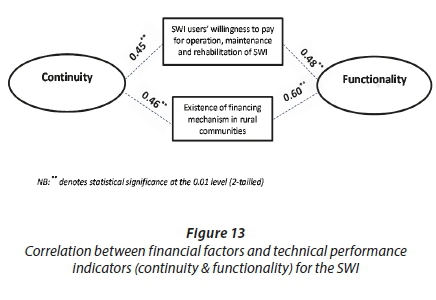
Willingness to pay (WTP) and the continuity and functionality of the small-scale water infrastructure
Finances are a major concern in infrastructural O&M as well as rehabilitation, as often there is insufficient funding to carry out O&M and rehabilitation (Karaa, 1984; Harvey, 2007). In rural infrastructure, availability of funds to cover O&M and rehabilitation cost is largely driven by the users' willingness to pay (Harvey, 2007; Wright et al., 2014), and often such funds are obtained through beneficiary contribution (Waughray et al., 1997; Senzanje et al., 2013). A two-tailed test of significance indicated that there was a significant positive relationship between continuity and WTP (rs (1) = 0.45, p < 0.01) and between functionality and WTP (rs (1) = 0.48, p < 0.01). Willingness to pay was found to be the only requirement for sustainable O&M and rehabilitation of SWI satisfied in sampled communities and not surprisingly it is associated with continuity and functionality of the system. Even those with dysfunctional SWI and low continuity expressed a willingness to pay for maintenance and rehabilitation. However, its association with continuity could be explained by collecting funds on time to carry out the maintenance or rehabilitation, although Harvey and Reed (2004) argued that willingness to pay does not necessarily mean users actually pay for maintenance and rehabilitation.
Existence of financing mechanism and the continuity and functionality of the small-scale water infrastructure
A two-tailed test of significance indicated that there was a significant positive relationship between continuity and existence of financing mechanism (rs (1) = 0.46, p < 0.01). A similar two-tailed test indicated that there was a significant relationship between existence of financing mechanism and functionality of SWI (rs (1) = 0.60, p < 0.01). A functional financing mechanism ensures that funds are readily available. Therefore, maintenance and rehabilitation processes are accelerated thus minimizing the number of days without water and the condition is also improved in the process. In rural communities of Zimbabwe where financing mechanisms have been established, the service provision is more continuous and the SWI were found to be operational most of the time (Waughray et al., 1997).
Technical factors
A series of Spearman rank-ordered correlations were conducted in order to determine if there was any relationship between technical factors (robustness of the SWI hardware, the availability of maintenance personnel and the availability of spare parts in local markets) and technical performance indicators (continuity and functionality). The results are displayed in Fig. 14.
Robustness of the SWI hardware and its continuity and functionality
A two-tailed test of significance indicated that there was a significant positive relationship between robustness of the SWI hardware and continuity of service provision (rs (1) = 0.33, p < 0.01). It was observed that the higher the robustness of the SWI the more continuous the service provision. A two-tailed test of significance also indicated that there was a significant positive relationship between robustness of the SWI and functionality of the small-scale water infrastructure (rs (1) = 0.41, p < 0.01). This was an indication that the higher the robustness of the SWI hardware the better the condition of the SWI.
This is the situation with a robust system since it takes a long time to reach the minimum acceptable performance levels and it also takes even longer before it experiences catastrophic failure. This improves the continuity of service provision and the condition remains good for a long period of time. As reported in the previous section, most of the villages with operational SWI (such as Schoonord and Phokwane (Ga-Maloka)) are not capacitated to carry out maintenance and rehabilitation of their SWI. However, they remain operational due to their robustness. Robustness is associated with various factors, such as design of the system, some of which did not fall within the scope of this study.
Availability of spare parts and the continuity and functionality of the small-scale water infrastructure
A two-tailed test of significance indicated that there was a significant positive relationship between continuity of the service provision and availability of spare parts (rs (1) = 0.41, p < 0.01). The higher the availability of parts the higher the continuity.
A similar test indicated that functionality of SWI was unrelated to availability of spare parts (rs (1) = 0.08, p < 0.01). Unavailability of spare parts either within the community or in the nearest town has implications for the duration of the period between a failed SWI and its re-operation. In the process of trying to find the spare parts, the SWI remains in a state of disrepair and the service provision is interrupted. This problem is common with hand pumps inherited from 2 or 3 decades before and the unavailability of spare parts for maintenance (Hazelton, 1994).
Availability of maintenance personnel for SWI and its continuity and functionality
A two-tailed test of significance indicated that there was a significant positive relationship between continuity of the service provision and availability of maintenance personnel (rs (1) = 0.46, p < 0.01). Continuity increased with availability of personnel. A similar significance test also indicated that there was a significant positive relationship between availability of maintenance personnel and functionality of the SWI (rs (1) = 0.62, p < 0.01). SWI were functional where maintenance personnel were in place. Engagement of the maintenance personal shortly after the SWI has broken down would accelerate the process of identifying maintenance requirements and will improve the continuity of service provision. When they are not found locally, the process of engaging them takes longer, thus service provision and condition are affected.
CONCLUSIONS AND RECOMMENDATIONS
It has previously been shown that a set of requirements exists for sustainable O&M and rehabilitation of SWI. This study sought to assess the presence of these requirements in Makhudutamaga Municipality: SWI users' sense of ownership towards SWI, SWI users' willingness to participate in their management, the existence of SWI management structures, the existence of financing mechanisms, SWI users' willingness to pay for O&M and rehabilitation of small-scale water infrastructure, robustness of the SWI hardware, the availability of maintenance personnel and the availability of spare parts in local markets.
It was found that the presence of the requirements for O&M and rehabilitation of SWI varied between communities, mainly due to different social dynamics. Overall, the requirements for sustainable O&M and rehabilitation of SWI were absent in the rural communities of Makhudutamaga Local Municipality, with the exception of one, i.e., users' willingness to pay for O&M and rehabilitation of SWI. Generally, there was a significant correlation between the requirements for sustainable O&M and rehabilitation of SWI and continuity of service provision, as well as functionality of the SWI hardware.
It is recommended that the ownership and the roles and responsibilities of different stakeholders in the O&M and rehabilitation of SWI be clarified to avoid second guessing of who owns what small-scale water infrastructure and who is responsible for what. It is also recommended that SWI users establish tariff collection system to ensure that funds to cover the cost of O&M as well as rehabilitation are readily available. However, this could easily be achieved if all of the other requirements were present, especially the establishment of management structures which has been reported to be of critical importance by several research studies.
It was recommended that SWI users and government departments should ensure the presence of the requirements for sustainable O&M and rehabilitation of SWI in order to achieve long-term sustainability for maintenance and rehabilitation of SWI. It is further recommended that studies that specify the sustainability of small-scale water infrastructure based on gender be carried out.
ACKNOWLEDGEMENTS
The authors would like to thank CGIAR for funding the study under the Challenge Program on Water and Food. Our gratitude goes to the Agricultural Research Council - Institute for Agricultural Engineering, South Africa, and the University of KwaZulu-Natal for supporting the study. We would like to extend our gratitude to reviewers of this article for their input in reshaping and improving the article.
REFERENCES
BARAKI YA and BRENT AC (2013) Technology transfer of hand pumps in rural communities of Swaziland: towards sustainable project life cycle management. Technol. Soc. 35 258-266. https://doi.org/10.1016/j.techsoc.2013.10.001 [ Links ]
BOTHA FS and VAN ROOY JL (2001) Affordable water resource development in Northern Province, South Africa. J. Afr. Earth Sci. 33 (4) 687-692. https://doi.org/10.1016/S0899-5362(01)00093-8 [ Links ]
COLIN J (1999) Village Level Operation Maintenance for Rural Water Supply: Lesson from Experience. Water and Environmental Health at London and Loughborough, London, UK. [ Links ]
GBADEGESIN AS and OLORUNFEMI F (2007) Assessment of rural water supply management in selected rural areas of Oyo State, Nigeria. African Technology Policy Studies Network. ATPS Paper No. 49. ATPS, Nairobi, Kenya. [ Links ]
HARVEY PA and REED RA (2004) Rural Water Supply in Africa-Building Blocks for Handpump Sustainability. WEDC, Loughborough University, London, UK. https://doi.org/10.2166/wp.2007.012 [ Links ]
HARVEY PA (2007) Cost determination and sustainable financing for rural water services in sub-Saharan Africa. Water Polic. 9 373-391. [ Links ]
HAZELTON DG (1994) The development of efficient community water supply system using deep and shallow well handpumps. WRC Report No. TT 132/00. Water Research Commission, Pretoria. [ Links ]
HOKO Z and HERTLE J (2006) An evaluation of the sustainability of rural water rehabilitation projects in Zimbabwe. Phys. Chem. Earth 31 699-706. https://doi.org/10.1016/j.pce.2006.08.038 [ Links ]
JONES SA and SILVA C (2009) A practical method to evaluate the sustainability of rural water and sanitation infrastructure systems in developing countries. Desalination 248 500-509. https://doi.org/10.1016/j.desal.2008.05.094 [ Links ]
KAHINDA J M, ROCKSTROM J, TAIGBENU AE, and DIMES J (2007) Rainwater harvesting to enhance water productivity of rainfed agriculture in the semi-arid Zimbabwe. Phys. Chem. Earth 32 1068-1073. https://doi.org/10.1016/j.pce.2007.07.011 [ Links ]
KARAA FA (1984) A decision support model for the investment planning of the rebuilding and rehabilitation of mature water distribution systems. Unpublished PhD Eng Dissertation, School of Civil Engineering, Massachusetts Institute of Technology, Cambridge, USA. [ Links ]
LOVELL C (2000) Productive Water Points in Dryland Areas: Guidelines on Integrated Planning for Rural Water Supply. ITDG Publishing, London, UK. https://doi.org/10.3362/9781780441306 [ Links ]
MAHLO J (2013) Personal communication, 26 September 2013. Mahlo, Department of Water Affairs, Polokwane, RSA. [ Links ]
MAJURU B, JAGALS P and HUNTER PR (2012) Assessing rural small community water supply in Limpopo, South Africa: Water service benchmark and reliability. Sci. Total Environ. 436 479-486. https://doi.org/10.1016/j.scitotenv.2012.07.024 [ Links ]
MAKUNGO R, ODIVO JO and THIDZUMBA N (2011) Performance of small water treatment plants: The case study of Mutshedzi Water Treatment Plant. Phys. Chem. Earth 36 1151-1158. https://doi.org/10.1016/j.pce.2011.07.073 [ Links ]
MARKS SJ ONDA K and DAVIS J (2013) Does sense of ownership matter for rural water system sustainability? Evidence from Kenya. J. Water, Sanit. Hyg. Dev. 3 (2) 122-133. https://doi.org/10.2166/washdev.2013.098 [ Links ]
MARKS SJ and DAVIS J (2012) Does user participation lead to sense of ownership for rural water system? Evidence from Kenya. World Dev. 40 (8) 1569-1576. https://doi.org/10.1016/j.worlddev.2012.03.011 [ Links ]
MORGAN P (1993) Maintenance, the key to handpump survival. Waterlines 11 (4) 2-4. https://doi.org/10.3362/0262-8104.1993.011 [ Links ]
NISHA KR (2014) Household participation in community-based rural water supply systems: experience from Kerala, India. Water Polic. 15 (4) 515-534. https://doi.org/10.2166/wp.2013.136 [ Links ]
PACEY A (1976) Hand-pump Maintenance in the Context of Community Well Project. Intermediate Technology Publications, London, UK. [ Links ]
PETER G and NKAMBULE SE (2012) Factors affecting sustainability of rural water schemes in Swaziland. Phys. Chem. Earth 52 196-204. https://doi.org/10.1016/j.pce.2012.09.011 [ Links ]
PRION S and HAERLING KA (2014) Making sense of methods and measurement: Spearman-Rho ranked-ordered coefficient. Clin. Simul. Nurs. 10 (10) 535-536. https://doi.org/10.1016/j.ecns.2014.07.005 [ Links ]
PROKOPY LS (2005) The relationship between participation and projects outcomes: Evidence from rural water supply projects in India. World Dev. 33 (11) 1801-1819. https://doi.org/10.1016/j.worlddev.2005.07.002 [ Links ]
RSA (Republic of South Africa) (1998) National Water Act. Act No. 36 of 1998. Government Gazette 19182. Government Printer, Cape Town. [ Links ]
RIETVELD LC, HAARHOFF J and JAGALS P (2009) A tool for technical assessment of rural water supply systems in South Africa. Phys. Chem. Earth 34 43-49. https://doi.org/10.1016/j.pce.2007.12.001 [ Links ]
SAHELY HR, KENNEDY CA and ADAMS BJ (2005) Developing sustainability criteria for urban infrastructure systems. Can. J. Civ. Eng. 32 72-85. https://doi.org/10.1139/l04-072 [ Links ]
SAMBO C (2015) Assessment of performance of small-scale water infrastructure for multiple uses in Nebo Plateau, Sekhukhune District, South Africa. Unpublished MSc Bioresource System Dissertation, School of Engineering, University of KwaZulu-Natal, Pietermaritzburg, RSA. [ Links ]
SENZANJE A, SAMBO C, DHAVU K and SELALA MS (2013) Rehabilitation guidelines: framework for small scale water infrastructure in the Limpopo Basin with a focus on rural boreholes, stand pipes and windmills. Technical Guideline No 1. Agricultural Research Council, Pretoria. [ Links ]
SENZANJE A, SIMALENGA TE and JIYANE J (2012) Definition and categorization of small-scale water infrastructure. Technical Brief No.1. Challenge Progamme on Water and Food, Limpopo Basin Development Challenge, ARC-IAE, Pretoria, RSA. [ Links ]
SORLINI S, PALAZZINI D, MBAWALA A and COLLIVIGNARELLI MC (2013) Is drinking water from 'improved sources' really safe? A case study in the Logone valley (Chad - Cameroon). J. Water Health 11 (4) 748-761. https://doi.org/10.2166/wh.2013.017 [ Links ]
SUTTON S (2004) Preliminary desktop study of potential for self-supply in Sub-Saharan Africa. WaterAid and Rural Water Supply Network, London, UK. [ Links ]
WAUGHRAY DK, LOVELL CJ, MORIARTY PB, BATCHELOR CH, NANGATI F, KEATINGE D, MTETWA G and DUBE T (1997) Community resource management and livelihood strategies. Report No. 97/1. Institute of Hydrology, Wallingford, UK. [ Links ]
WRIGHT SG, MURALIDHARAN D, MAYER AS and BREFFLE WS (2014) Willingness to pay for improved water supplies in rural Ugandan villages. J. Water, Sanit. Hyg. Dev. 4 (3) 490-498. https://doi.org/10.2166/washdev.2013.011 [ Links ]
Received 12 December 2017
Accepted in revised form 3 April 2019
* To whom all correspondence should be addressed. e-mail: dhavuk@arc.agric.za














